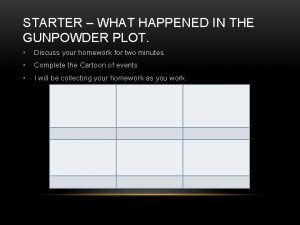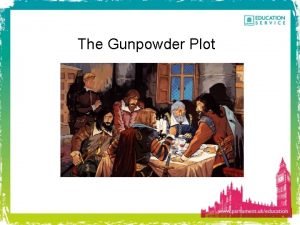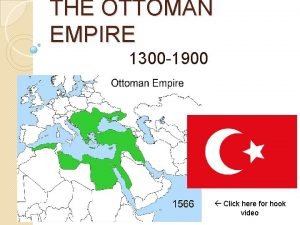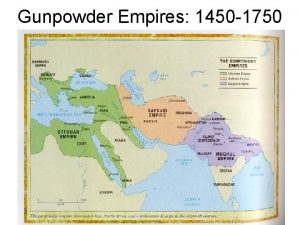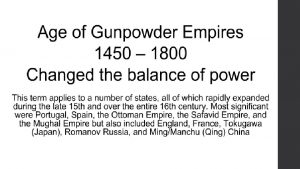The Gunpowder Plot The plotters plan was to









- Slides: 9


The Gunpowder Plot • The plotters’ plan was to blow up the House of Lords during the State Opening of Parliament on 5 th November 1605. They tried to kill the king and his government. • The plotters wanted to take action against the government and the king for their anti-Catholic laws. They planned to put James I’s daughter, Elizabeth, on the throne. • In the summer of 1605, the group hired a cellar underneath Parliament and secretly brought in barrels of gunpowder. • After a secret letter revealing the plot was sent to Lord Monteagle, Parliament was searched for traces of the plotters. In the cellar below the House of Lords, the guards found the gunpowder and Guy Fawkes.

The Key Figures • Guy Fawkes joined the plotters in 1604 and was the man responsible for lighting the fuses underneath Parliament. Before he could go through with the plan, he was captured, the plot was foiled and he was tried for treason. • James I became King of England in 1603 and was the first Stuart monarch. He was also King of Scotland united the two countries. • Robert Catesby was the organiser and leader of the gunpowder plot. He was killed fighting with the guards who came to arrest him. • Lord Monteagle received an anonymous letter warning of a ‘terrible blow’ to come during the state opening. He took the letter to the king and secrets of the plot were discovered. He was rewarded by the king after the plot was foiled.

The Legacy • After three days of torture in the Tower of London, Guy Fawkes named his fellow plotters and they were put to trial and sentenced to be hanged, drawn and quartered. • Londoners were encouraged to burn bonfires to celebrate the failure of the plot and the government passed a law designating November 5 th as a national day of thanksgiving. • Although the law no longer exists, many still celebrate bonfire night with fireworks to mark the occasion.

Britain in 1604 • England was a Protestant country. • James I, King of England, refused to treat Catholics as equals. • Britain had endured almost 100 years of religious persecution between Protestantism and Catholicism. Queen Mary I, a Catholic, launched a cruel campaign of oppression against the Protestant population. • Elizabeth I, a Protestant, organised a similarly brutal crackdown on Catholicism. Hundreds were burned to death for simply practising their faith.

Persecution • To this day, we celebrate the failure of the gunpowder plot with fireworks and bonfires. • The gunpowder plot was the culmination of 100 years of religious persecution and conflict. • The question remains – why did the plot take place and how can such problems be resolved? • A just society must represent all its citizens, not just a select group. If one group is given some rights over another, conflict is never far away.

Time for Reflection • Can you think of any group of people which is persecuted today? In what ways can people be heard and make changes in our country today? • Spend a few moments thinking about the religious freedoms we have in this country. Even if you have no faith, you are exercising the freedom to not have a faith; no one will make you go to church every week or follow a particular religion as they did at one time. • Let’s be glad we have that freedom to be ourselves and work to keep those freedoms alive

How to keep safe around fireworks • • • Never throw fireworks Keep pets indoors Never go back to a lit firework Always wear gloves with sparklers Keep fireworks in a closed box

